Best Uses for Wood Stove Ash 2024
- April 10, 2024
- 23 comment
Discover the unexpected benefits of wood stove ash in 2024, a substance with a rich history of utility dating back at least 5,000 years. Often overlooked and merely swept away, this byproduct from your fireplace or wood stove is actually a hidden gem for home and garden enthusiasts. In our comprehensive guide, we delve into eight innovative ways to utilize wood ash, transforming what seems like a mundane substance into a versatile powerhouse for your home.
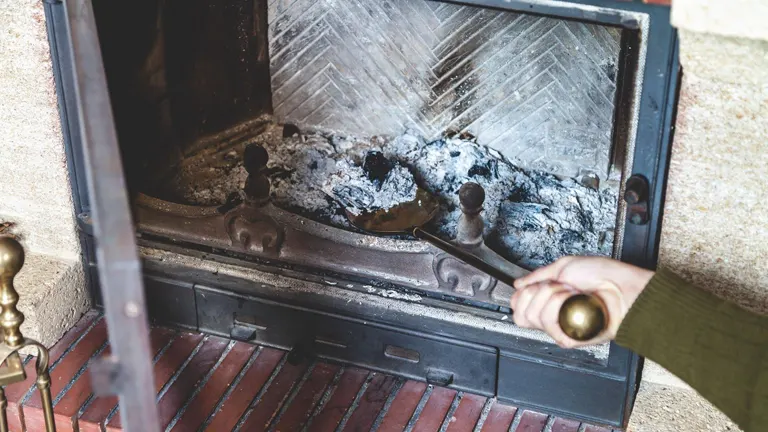
From boosting your garden’s health to acting as a natural cleaner, wood ash offers a plethora of surprising advantages. It’s not just about enriching soil or providing eco-friendly alternatives; wood stove ash embodies a wealth of potential waiting to be tapped into. Join us in exploring these practical, yet often underappreciated, uses of wood ash and discover how it can significantly enhance your daily life.
What Is Wood Ash?
Wood ash is what’s left after burning wood or wood products. Its makeup varies widely, depending on several factors. Hardwoods usually produce more ash than softwoods, and the outer parts of the tree like bark and leaves make more ash than the inner wood. On average, you’ll get 6 to 10 percent ash from burning wood. In industrial contexts, the ash’s features can change based on how hot the fire was, the type of wood burned, and how the burning process was carried out. This means wood ash can be different in different places or in various industries, highlighting the need for ash testing.
Wood Ash is composed of these Primary Elements:
| Element | Composition (%) |
|---|---|
| Carbon (C) | 5–30% |
| Calcium (Ca) | 7–33% |
| Potassium (K) | 3–10% |
| Magnesium (Mg) | 1–2% |
| Manganese (Mn) | 0.3–1.3% |
| Phosphorus (P) | 0.3–1.4% |
| Sodium (Na) | 0.2–0.5% |
Wood ash is full of important elements that trees pull from the soil and air, which are beneficial for growing crops and plants. Calcium, which acts similarly to agricultural lime, is the most common element in wood ash. It’s also a good source of potassium, phosphorus, and magnesium, making it comparable to a 0-1-3 (N-P-K) fertilizer. Wood ash includes many minor nutrients vital for plant health and usually has low levels of heavy metals, making it environmentally safe.
List of Best Uses for Wood Stove Ash:
- Gardening Companion
- Natural Pest Deterrent
- Green Cleaning Solution
- Ice Melting Aid
- Odor Neutralizer
- Soap Making Ingredient
- Artistic Medium
- Poultry Care Enhancer
- Silverware Shiner
- Food Preservation Method
10 Best Uses of Wood Ash
1. Gardening Companion
Gardening is more than a hobby; it’s an art that combines soil, water, and sunlight in a delicate balance. Amidst this natural orchestra, Wood Ash emerges as an unsung hero. This seemingly mundane byproduct of fires is, in fact, a powerhouse of nutrients, crucial for a thriving garden.
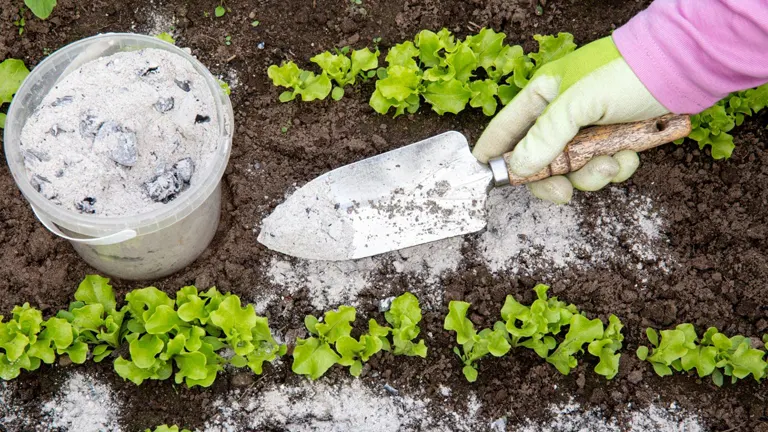
The Nutrient-Rich Profile of Wood Ash
Wood ash is far more than just a gray residue; it’s a repository of essential minerals. Its composition is rich in potassium, calcium, and magnesium, each playing a vital role in plant health:
- Potassium: Known as the “quality nutrient,” potassium is crucial for plant health. It regulates water uptake, enzyme activation, and photosynthesis. Plants with sufficient potassium show increased disease resistance, efficient water use, and produce high-quality fruits and flowers.
- Calcium: Essential for cell wall formation, calcium ensures strong stems, leaves, and roots. It also helps neutralize acidic soils, maintaining optimal pH levels for plant growth.
- Magnesium: Central to the chlorophyll molecule, magnesium is vital for photosynthesis. It ensures plants effectively convert sunlight into energy, promoting healthy, green growth.
- Trace Elements: Wood ash also contains trace elements like boron, copper, and zinc, which are instrumental in supporting various aspects of plant growth and health.
Application
Using wood ash in gardening requires a thoughtful approach. A light sprinkle over garden beds acts as a natural, slow-release fertilizer, enriching the soil gradually. However, excessive use can disrupt soil pH and nutrient balance. A thin, even layer is key, allowing plants to benefit without the risk of nutrient overload.
Storage and Usage Tips
Store wood ash in a dry, sealed container to preserve its nutrient content. Before application, conduct a soil pH test. This helps tailor the use of wood ash, avoiding overly alkaline conditions.
Wood ash can quickly raise soil pH, more effectively than limestone due to its water solubility. The ideal soil pH is between 6.0 and 7.0. If your soil is within this range, adjusting pH may not be necessary.
Different plants have varying pH preferences. For instance, tomatoes thrive in soil rich in calcium and potassium, nutrients abundant in wood ash. In acidic soils, wood ash can be particularly beneficial, providing the necessary calcium and potassium for healthy vegetable growth.
2. Natural Pest Deterrent
Gardeners have long faced the challenge of pests like slugs and snails, notorious for damaging plants. These pests are resilient and reproduce quickly, necessitating an effective, eco-friendly deterrent. Wood stove ash, a natural byproduct of burning wood, emerges as an eco-friendly solution. Its powdery texture creates a physical barrier that’s unpleasant for slugs and snails. These pests, which move using a mucus-secreting muscular foot, find the fine particles of wood ash uncomfortable, as it absorbs their mucus, hindering their movement. This is akin to the difficulty humans face when walking on a shifting sandy beach.
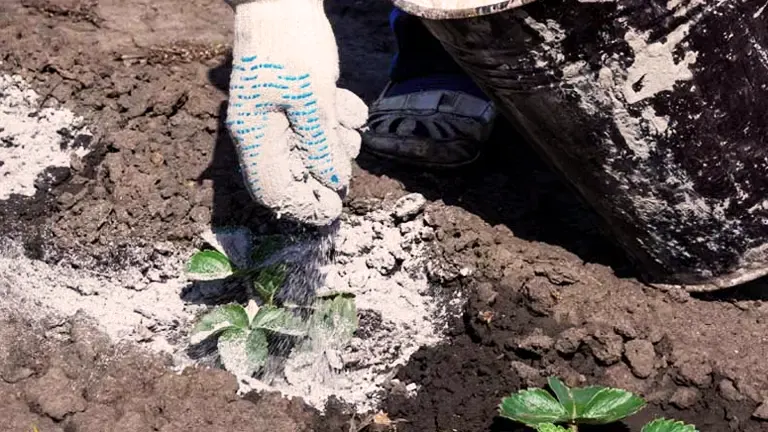
Creating a protective barrier with wood ash is simple. Sprinkle a continuous circle of ash around plants at risk, forming a protective ring. This barrier deters pests before they can reach and damage the plants. Beyond slugs and snails, wood ash can also disrupt the pheromone trails of ants, making it a versatile pest control solution. Choosing wood ash over chemical repellents is beneficial for the environment. It’s safe for beneficial insects, birds, and the soil ecosystem.
Effective Application Tips
- Wood ash can be dispersed by wind or rain, so regular reapplication is necessary, especially after heavy rainfall.
- Ensure there are no gaps in the ash circle, as these can be exploited by pests.
- Mix wood ash with crushed eggshells for a more effective barrier. This combination not only deters pests more effectively but also adds beneficial calcium to the soil.
3. Green Cleaning Solution
In our quest for spotless homes, we often turn to chemical cleaners, but an ancient, natural alternative awaits rediscovery: wood ash. This byproduct of wood combustion is not just a remnant of a cozy fire; it’s a potent cleaning agent.
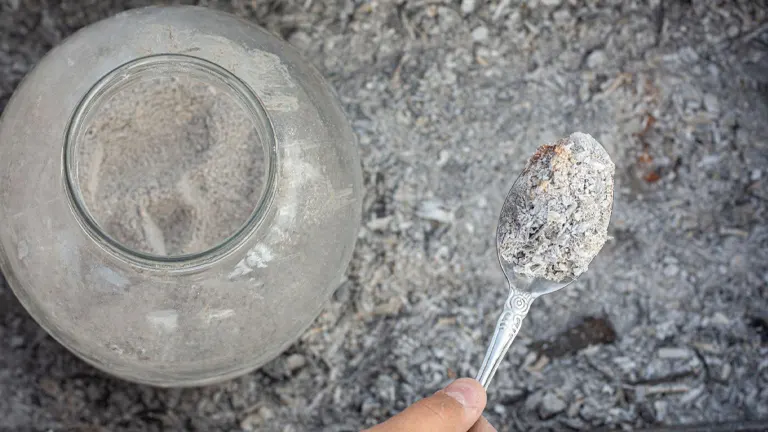
Wood ash is primarily composed of mineral residues left after wood burns. Its mildly abrasive texture is akin to commercial scouring powders, making it an effective, natural cleaner. This abrasiveness helps dislodge grime, stains, and residues from various surfaces, offering a gentle yet powerful cleaning solution.
Creating an Effective Wood Ash Cleaner
- Collect and sieve wood ash to obtain fine particles, eliminating larger pieces that could scratch surfaces.
- Mix the sieved ash with water to create a paste, aiming for a toothpaste-like consistency.
- Apply this paste with a cloth or brush, scrubbing gently in a circular motion. The moisture and granular nature of the ash lift stains effectively, especially from hard surfaces like metal and glass.
Versatile Cleaning Applications
- For Metals: Use the ash paste to clean stainless steel, copper, and cast iron, removing discolorations and burnt-on food. Rinse thoroughly afterward for a gleaming finish.
- For Glass: Tackle smudges and watermarks on glass surfaces with the ash paste, followed by a wipe with a damp cloth to restore clarity.
- Natural Silver Polish: Gently polish tarnished silverware with the ash paste, then rinse to reveal a renewed shine.
Tip: Always conduct a patch test on a small area before using wood ash on larger surfaces to ensure compatibility.
4. Ice Melting Aid
The beauty of winter often comes with the peril of icy pathways. While chemical de-icers are common, wood ash presents a sustainable, effective alternative for melting ice and improving safety.

Understanding the Ice-Melting Power of Wood Ash
- Heat Absorption: The key to wood ash’s effectiveness lies in its dark color. This characteristic enables it to absorb and retain solar heat. When spread over icy surfaces, the ash absorbs sunlight, transferring this heat to the ice. This process accelerates melting, particularly effective during sunny winter days.
- Traction Enhancement: One immediate benefit of using wood ash on ice is the improved traction. Its granular texture creates a gritty layer on slippery surfaces, significantly reducing the risk of slips and falls. This makes it an ideal solution for icy driveways, walkways, and steps, where safety is a primary concern.
- Environmental Safety: In contrast to many commercial de-icers that contain harsh chemicals, wood ash is a natural byproduct of wood burning. This makes it a more environmentally friendly option. It’s generally safe for use around plants and poses minimal risk to groundwater, making it a responsible choice for those conscious of its environmental impact.
Optimal Use of Wood Ash for Ice Melting: Tips and Tricks
- The first step in using wood ash effectively is to ensure its quality. Only use ash from untreated, unpainted wood. This precaution is crucial to avoid introducing harmful chemical residues into your environment.
- To get the best results, spread a thin, even layer of wood ash over icy areas. This method not only prevents messy residues after the ice melts but also helps your ash supply last longer through the winter season.
- Keep your wood ash in a dry, sealed container. Moisture can reduce its effectiveness and make it difficult to spread evenly. Proper storage ensures that the ash remains potent and ready to use when needed.
- Choose the right time to apply wood ash. Avoid windy conditions, as the ash can easily blow away, reducing its effectiveness. Early mornings or calm weather conditions are ideal for application.
- For an even more effective solution, consider mixing wood ash with other organic materials. Adding coffee grounds or beet juice to wood ash not only improves its de-icing capabilities but also utilizes available resources efficiently and sustainably.
5. Odor Neutralizer
Wood ash is more than just a byproduct of fire; it’s a potent natural remedy for combating unpleasant odors. Its composition is rich in carbon compounds and minerals, which are inherently porous. This structure is akin to that of activated charcoal, renowned for its absorption capabilities. Wood ash works on a similar principle, trapping and neutralizing odor-causing molecules, thereby rendering them ineffective.
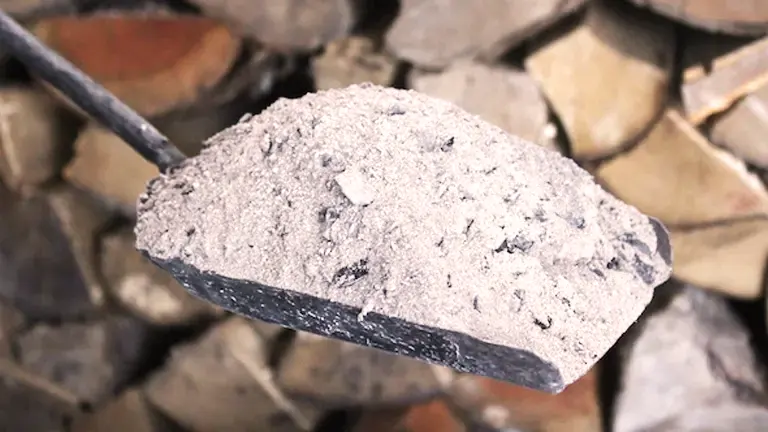
Diverse Applications in Odor Management
- In outdoor spaces, such as gardens or areas where pets frequent, wood ash proves invaluable. It effectively absorbs ammonia and other volatile compounds that are often the culprits behind persistent odors. By simply sprinkling a layer of wood ash over these areas, you can significantly reduce unpleasant smells.
- For indoor spaces plagued with dampness or staleness, like basements, attics, or storage rooms, wood ash can be a game-changer. Placing a bowl of wood ash in these areas helps to draw out and neutralize musty odors, restoring freshness.
- Just as baking soda is a go-to solution for fridge odors, wood ash can play a similar role. A small container of wood ash placed in the refrigerator can absorb strong food odors, maintaining a neutral and fresh environment inside.
- Tackling the challenge of smelly shoes, wood ash offers a simple yet effective solution. A sachet filled with wood ash, left inside the shoes overnight, absorbs both moisture and odor, leaving the shoes fresher and more pleasant to wear.
Optimizing Wood Ash Use for Maximum Effectiveness
- The efficacy of wood ash in odor control is at its peak when it’s fresh. Older ash, particularly if it has been exposed to moisture, may not be as effective.
- When it comes to using wood ash, less is often more. A thin layer or a small quantity is usually sufficient to tackle odors. Excessive use can lead to unnecessary mess and waste.
- While wood ash is a fantastic natural solution, it’s important to handle it safely. Always wash your hands after use, and be cautious to prevent it from becoming airborne, especially indoors, to avoid respiratory irritation.
Tip: To add a pleasant twist to wood ash’s odor-neutralizing properties, consider creating sachets mixed with dried herbs like lavender or rosemary. This not only combats odors but also infuses the area with a subtle, refreshing fragrance.
6. Soap Making Ingredient
Soap-making is an age-old art, and wood ash plays a surprisingly pivotal role in this craft. It’s the key to creating lye, a crucial ingredient in traditional soap-making. This process harkens back to a time when everyday items were crafted from natural, locally sourced materials.
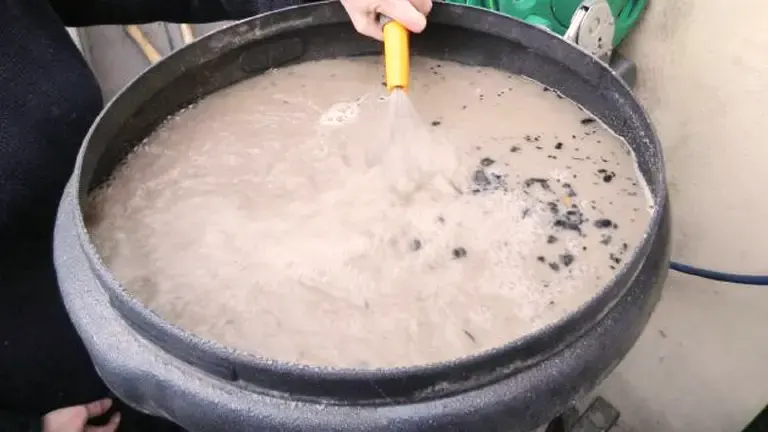
Wood ash contains salts and compounds that, when leached with water, produce a basic solution. The process is akin to a touch of old-world chemistry, taking us back to times when household goods were made from readily available resources.
Extracting Lye from Wood Ash: The Foundation of Soap Making
- Start by gathering clean, white ash from hardwoods like oak or maple. It’s vital to ensure the ash is free from contaminants like treated or painted wood.
- Use a bucket with small holes at the bottom. Layer the wood ash and pour rainwater or distilled water over it. The water leaches out potassium-rich lye as it filters through the ash.
- The strength of the lye is crucial. Test it by placing a fresh egg or a potato in the solution. The ideal concentration is indicated when these items float midway. Adjust the concentration as needed based on their buoyancy.
The Art of Soap Synthesis
- Traditional soap recipes often use animal fats like tallow or lard. Melt and clarify these fats to remove impurities.
- Gradually mix the lye solution with the melted fats, stirring continuously. This reaction, known as saponification, transforms the mixture into soap. Continue until it reaches the “trace” stage, where the soap begins to thicken.
- Pour the mixture into molds and let it set. Once solidified, cut the soap into bars and cure them for several weeks to improve their texture and efficacy.
Tip: If you’re keen on adding fragrances or textures, consider integrating essential oils, dried herbs, or oatmeal during the trace stage. They infuse the soap with pleasant aromas and offer gentle exfoliation or added skin benefits.
Note: Lye is caustic and requires careful handling. Always wear protective gear and work in a well-ventilated area, away from children and pets.
7. Artistic Medium
In the dynamic world of art, wood ash emerges as a unique and potent medium. This simple byproduct of hearth and stove transcends its humble origins, offering artists a spectrum of natural hues and textures. From delicate grays to subtle blues and purples, wood ash reflects the elemental beauty of earth and fire.
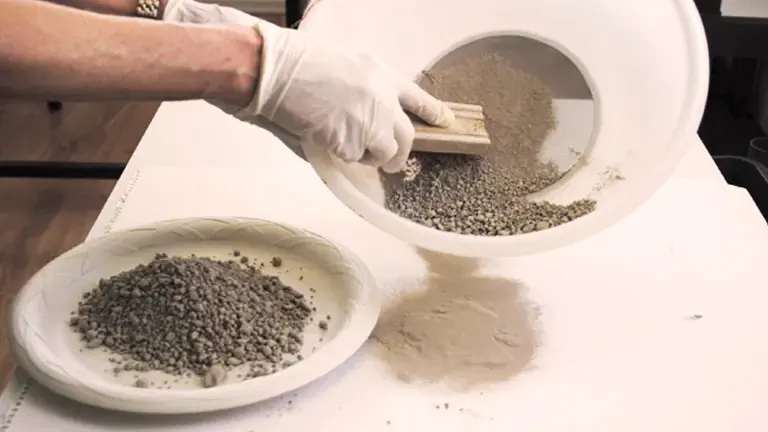
Crafting the Perfect Artistic Medium with Wood Ash
- Begin by sieving the wood ash to obtain the finest particles, ensuring a refined quality in the artwork.
- Binders are crucial in transforming ash into a workable medium. Options include linseed oil for an oil paint effect, egg yolk for a tempera texture, or gum Arabic for a watercolor feel.
- Adjust the ratio of ash to binder to achieve the desired texture. More ash results in a denser, grainier mix, while more binder creates a smoother consistency.
The Unique Artistic Expressions of Wood Ash
- Wood ash adds a tactile dimension to art, inviting touch with its inherent graininess.
- It lends a monochromatic, old-world charm to artworks, with occasional color surprises based on its origin.
- In mural art, wood ash can create rustic, profound visual narratives.
- Combining wood ash with other materials like inks, pigments, or organic elements can result in mixed media pieces that are both meaningful and visually stunning.
Connecting with Nature Through Art
Using wood ash in art symbolizes a deep connection with the earth. It’s a tribute to the cycles of life, death, and renewal, echoing the stories of nature through every brushstroke.
Tip: For artists wanting to further preserve the tonal qualities and texture of wood ash, consider using fixatives or sealants post-painting. Not only will this prolong the artwork’s lifespan, but it will also accentuate the rich details and contrasts inherent in the medium. Additionally, experimenting with varying burn temperatures and wood types can offer a broader spectrum of colors and textures, thereby expanding the artist’s creative horizons.
8. Poultry Care Enhancer
Witnessing chickens indulging in their dust baths is not only a delightful scene but also a crucial aspect of natural poultry care. These dust baths, which include rolling, fluffing, and frolicking in the dust, are fundamental to the health and well-being of chickens.
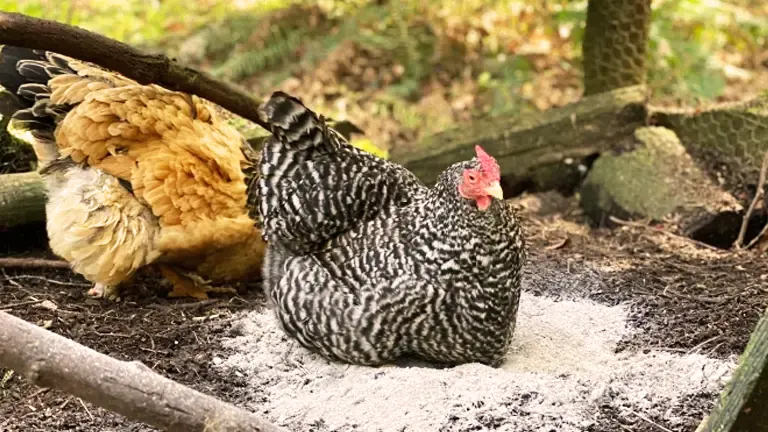
Understanding the Dust Bath Ritual
- Chickens naturally use dust baths as a form of pest control. The fine dust particles infiltrate their feathers and skin, creating an environment that’s unwelcoming for parasites such as mites and lice.
- These baths are vital for the maintenance of the chicken’s plumage, helping in cleaning and aligning feathers, and ensuring optimal condition and health.
- Similar to a cat’s joy in catnip, chickens find great pleasure and relaxation in dust baths. This activity is not just physical but also serves as a mental and emotional stimulant for them.
The Wood Stove Ash Enhancement
- Wood ash, with its fine and powdery texture, boosts the dust bath’s pest-repellent qualities. The alkaline properties of the ash create an even more hostile environment for parasites, reinforcing the bath’s efficacy.
- Wood ash is laden with a variety of minerals. While primarily used for pest control, these minerals can be an incidental nutritional supplement for the birds, especially if they peck at the ash-infused dust.
- Mixing wood ash with regular dust results in a finer, more luxurious texture. This improved blend ensures better coverage, reaching every part of the chicken’s plumage, offering thorough protection and cleaning.
Best Practices for Using Wood Stove Ash in Poultry Dust Baths
- Ensure that the wood ash is free from large chunks, residues, or unburnt wood pieces to prevent potential harm to the chickens.
- Periodically replenish the dust bath with fresh wood ash to maintain its effectiveness and potency.
- Position the dust bath in a shaded and dry area. This prevents the wood ash from becoming damp, which could reduce its effectiveness.
9. Silverware Shiner
Silverware is more than just a dining accessory; it is a symbol of elegance, a piece of history, and a testament to craftsmanship. Over time, however, the beautiful shine of silverware can become diminished due to the inevitable tarnish that occurs. A remarkable yet traditional method has resurfaced, offering a sustainable, efficient, and cost-effective way to restore and maintain the luster of silverware: wood ash.
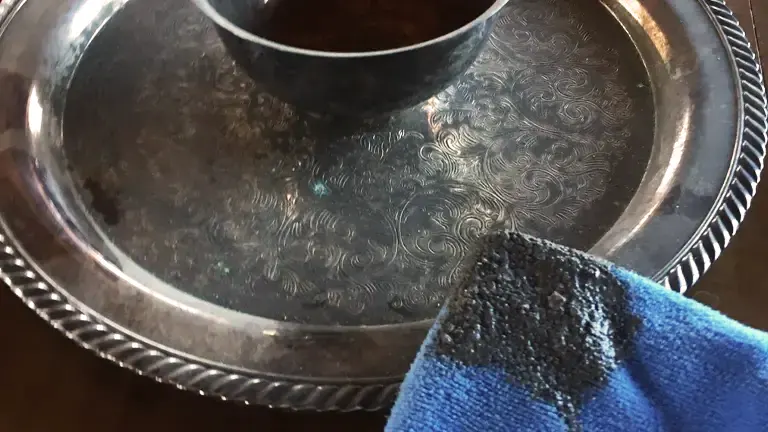
Understanding the Science Behind Tarnishing
Silver tarnish occurs when silver reacts with sulfur compounds in the air, forming a layer of silver sulfide, which appears as a blackish discoloration.
- Wood ash’s gentle abrasiveness makes it perfect for cleaning without damaging the delicate silver surface.
- The alkaline nature of wood ash is thought to neutralize acidic compounds on the silver, aiding in tarnish removal.
Steps for Using Wood Ash to Shine Silverware
- Ensure the wood ash is finely powdered to avoid scratching. Sift to remove any larger, unburned particles.
- Mix the fine wood ash with a bit of water to form a thick, spreadable paste.
- Gently apply the paste using a soft cloth or sponge in circular motions. For heavily tarnished areas, let the paste sit for a few minutes.
- Thoroughly rinse with warm water and dry immediately with a soft cloth to prevent water marks.
- Use a clean, soft cloth for a final polish to bring out the silver’s natural sheen.
Tip: For tougher tarnish, add a small amount of lemon juice or white vinegar to the paste. The acidic properties of these ingredients can enhance the effectiveness of the wood ash.
10. Food Preservation Method
Embarking on a camping adventure in the wilderness brings us face-to-face with the age-old challenge of preserving food without the luxury of modern refrigeration. However, nature offers a time-honored solution that has been utilized long before the advent of electrical appliances: wood ash, a natural preservation agent.
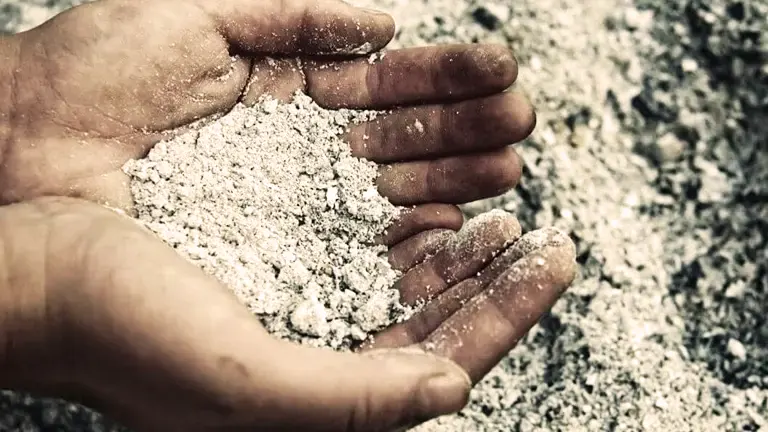
The historical roots of using wood ash for food preservation are deeply embedded in Native American traditions, showcasing a remarkable understanding of natural preservation techniques. Indigenous peoples adeptly utilized wood ash to protect their vital food supplies, particularly in conditions where conventional preservation methods were unavailable. The technique they employed was both simple and effective: food items such as apples, potatoes, and other root vegetables were stored in a pit, carefully layered with wood ash.
This method created a protective barrier that guarded the food against moisture, insects, and other elements that contribute to spoilage. The role of wood ash in this process is twofold. Primarily, it serves as a desiccant, absorbing excess moisture from the environment. This reduction in moisture significantly hinders bacterial growth, a primary cause of food spoilage. Additionally, the unique properties of wood ash help in creating an environment that is less conducive to the survival of spoilage-causing organisms. This natural and ingenious use of wood ash effectively extends the shelf life of the produce, a testament to the ingenuity of traditional preservation methods.
Implementing Wood Ash Preservation
- Dig a shallow pit in a dry area. Place a layer of wood ash at the bottom, followed by a layer of the produce, and alternate between the two, ending with a layer of ash.
- Cover the pit with a wooden plank or a similar barrier to protect it from animals and natural elements.
- Ensure that the pit is easily accessible for monitoring and usage, but also secure enough to prevent any disturbance.
Handling and Precautions with Wood Ash
- Always store wood ash in a metal container with a tight-fitting lid. This container should be kept away from any potential fire hazards.
- If you plan to use the ash in a garden, ensure it comes from untreated wood. Ash from painted or chemically treated wood can contain harmful substances.
- Use the ash sparingly, especially in gardening. Excessive use can alter soil pH. Regular soil testing is advisable if using ash as a soil amendment.
Tip: For effective use of wood ash in food preservation, ensure the ash is cool and free of active embers to avoid fire risks and protect the food. Campers should choose a dry area for the storage pit and sift the ash to remove large particles. At home, a cool, dry basement is ideal for this method. These precautions help maximize the natural preservation benefits of wood ash.
Expand Your Understanding of Wood Stoves: Dive into our related articles listed below. Whether you’re a novice or a seasoned stove enthusiast, there’s always something new to learn and discover!
- How to Install a Wood Stove
- How to Maximize Your Wood Stove Uses 2023
- How to Clean and Maintain Your Wood Stove 2023
- How to Remove Rust and Restore a Wood Stove 2023
- How to Install a Wood Stove in the Basement 2023
- How to Choose the Best Wood Burning Stove Insert 2023
- How to Cool Down a Wood Stove Quickly 2023
- How to Replace Wood Stove Fire Brick 2023
- How to Replace the Gasket on a Wood Stove 2023
- How to Remove Creosote from a Wood Stove 2023
- How to Choose the Right Wood Cooking Stoves for Your Needs
FAQs
- What Magic Lies in Wood Ash?
Wood ash is the enchanting residue that remains after wood dances with fire. It holds the secrets of a tree’s journey through flames. - Can My Garden Befriend Wood Ash?
Yes, your garden can forge an alliance with wood ash. It offers a sprinkle of minerals and plant tales from the hearth. - How Do I Whisper Wood Ash to My Garden?
Share whispers of wood ash gently, for its stories can change soil songs. Blend it in, and listen closely to your garden’s harmony. - Can Wood Ash Join the Compost Masquerade?
Indeed, wood ash can don the compost mask, tempering acidity. Yet, ensure it’s not a painted imposter, carrying toxic secrets. - Will Wood Ash Protect Plants in a Guardian Dance?
Within limits, wood ash guards the garden like a loyal sentinel. But beware overenthusiastic guards—too much might summon alkaline troubles. - Can I Invite Burnt Wood Paint to the Garden Gala?
No painted promises at this garden soiree. Keep the wood ash guest list free from tainted characters that harbor chemical mysteries. - Can Wood Ash Melt Ice in the Winter Ballet?
Wood ash can pirouette on icy stages, a rustic de-icer. Yet, it’s no prima ballerina compared to commercial ice maestros. - Does Charcoal Hold Hands with Wood Ash?
Charcoal and wood ash waltz hand in hand but remember, charcoal might have whispers of additives, while wood ash carries the true forest‘s essence. - Can Ashes Cleanse like Ancient Rituals?
Yes, like ancient cleansing rituals, wood ash can scrub away grime, revealing the shine underneath. But first, a small ceremony to test its power.
And there you have it – our journey through the Best Uses for Wood Stove Ash 2024! What did you think? If you’ve dabbled in any of these uses, or if you’ve stumbled upon other cool ways to utilize wood stove ash, we’d love to hear your stories! Drop a friendly comment below and let’s get chatting. Sharing is caring, so if you found this piece intriguing, why not pass it along to friends or on your social channels? Let’s keep this cozy conversation going and learn from each other. Cheers to the warmth of the community and the wonders of wood ash!

David Murray
Forestry AuthorI'm David Murry, a forestry equipment specialist with a focus on chainsaw operation. With over 13 years of experience, I've honed my skills in operating and maintaining a wide range of machinery, from chainsaws to log splitters. My passion for the outdoors and commitment to sustainable forestry drive my work, which emphasizes safety, efficiency, and staying updated with industry advancements. Additionally, I'm dedicated to sharing my expertise and promoting environmental awareness within the forestry community.
23 comments
I love this article. I wanna embrace natural remedies as much as possible só this is useful. Appreciate it
Washington
September 17, 2023 4:06 pmI put piles of wood ashes out for quail and turkeys and other birds to Dust in Paths or openings in the hardwood forest The rain will compact, but then they dig it back up and dust away on a daily basis West Central Indiana
Hansford
August 31, 2023 3:00 amCan you use the ashes if you have used a fire log to start the fire (i assume there is an accelerant in the wrapper)?
Kathryn Smith
August 28, 2023 7:44 pmI use the ash from my stove to clean the stove glass. Rub it all over the glass and then polish of using kitchen roll. Perfect every time!
Lynn Atkinson
August 28, 2023 12:32 pmGreat article! I gonna try to join the Garden Gala 🤣
Griffin Stello
August 28, 2023 10:46 amWhen I transplant flowers etc, I mix a small handful with soil and put in the hole. My plants love it. Sure would be nice if it were a mole deterrent as well.
Karen D.
August 28, 2023 2:34 amMole runs seem to be usually about 20cm underground. Also they can be more than a 100 meters long. If practice one can dig a trench 30 cm deep and place a board or similar object on its side in the trench and close the trench. The object then is not visible to the eye but forms a barrier so they cannot get through to your plants. You can also use river sand on the trench. This is not hard so it collapses when they tunnel. There are vicious poisons but the problem is they kill everything from earthworms to a lot of bacteria. They say garlic works but have had no success with it. Good luck.
Keith
August 29, 2023 4:52 amWonderful tips. Before modern tooth pastes wood ash worked miracles as a toothpaste
This is a most awesome article. Never knew all the benefits and always have a fireplaces going in winter. Thank you so much.
Jean
August 27, 2023 2:00 pmUse wood ash on your dirt roads and gravel paths. Mix it with dirt and rocks sand and water. Like concrete ends up hard and solid
Scott Moore
August 27, 2023 4:55 amThis is really great info, thanks for sharing!
John S
August 27, 2023 3:58 amWood ash can also be used as a pottery glaze. Mix with water to a pleasing consistency and dip the pot in. Place in kiln and fire and it will produce a pleasing waterproof glaze.
Calcitestar
August 27, 2023 3:27 amLove this article!!
Good 4 onions
Thank you for a comprehensive, engaging and informative overview of the many benefits to be derived from wood ash.
Ani
August 26, 2023 6:05 pmlove both the way its written & the content. Thank you!
MARY SPEERS
August 26, 2023 5:36 pmThank you very much for the info especially on making home made soap,Woodash can also be poured in toilets pit except it's antibacterial properties it also removes bad smell
Tiny
August 26, 2023 12:36 pmI have tried various commercial fireplace glass cleaners and none of them measure up to using wood ash to clean my fireplace and wood stove glass doors. Plus, the savings of spending $10+ for a chemical versus $0 for wood ash - well, you know what I mean. Try it, you won't be disappointed.
Heidi Launer
August 26, 2023 11:56 amAs a wood burning household for many years we've always used ash around trees, gardens and driveway in winter months, all with great results, it really does work, no pests and growth is worth the extra work of filtering. Thank you for writing this, it is so important to use what nature has provided us.
Dawn
August 26, 2023 6:49 amI use wood ash pesticides for poultry,
Johannes
August 26, 2023 6:27 amYou forgot what I think is the most important: wood ash has antibacterial qualities. Apply it to a wound to stop bleeding instantly it also prevents it from becoming infected and it heals it. You want the ashes from wood not from garbage,styrofoam, cans etc that have been burned in your fire pit. So next time you're camping, or if you have a wood stove you have a valuable emergency medicine. Keep some in a jar for emergencies. Obviously no chunks, only the fine powdery stuff.
Karen
August 25, 2023 9:30 pmWonderfully lyrical writing contains many good tips for the use of wood stove ash. A pleasure to read. Have been implementing some of theses for some time but great to read in this poetic formula. Thank you 😊🪴













Wood ashes is great for cleaning up oil spills on garage floors
Joe Trombley
September 27, 2023 10:09 am